Student culture
One of the main goals for LTKY is to promote student culture and a sense of community. We want to ensure that both teekkari and kylteri culture is seen on our campus and that traditions are respected. At the same time, we try to improve our traditions to fit in the present. It is important for us that according to Skinnarila Spirit everyone feels a part of the community on our campus.
Student-English dictionary
Below are the most important words belonging to the Teekkari and Kylteri slang in Lappeenranta. With these skills, you can stay on the cart of what is being talked about.
Table of Contents
AALEF
A company owned by the Student Union. It runs a kiosk and two restaurants in Lappeenranta campus
AETHER
Student association for all the international programs at the LUT Lahti campus, identified by dark yellow overalls
ALIVE
The online media of the Student Union, with colorful stories and articles about LUT students and life on campus
ARMATUURI
Energy technology guild, white overalls
CLUSTER
Information technology guild, red overalls
CREDIT
Credits should be collected in order to achieve the title of Master of Science (MSc) or Master of Business Administration. Credits are also referred to as “noppa”
DOMINUS
Student association of Social Sciences and Communication sciences
EXCURSION
A trip made usually by bus, may include business visits and other nice activities
eLUT
An online student service that gathers study-related information, support services, and all other necessary information at the same site
ENKLAAVI
Student association of Business Administration students, neon yellow overalls
ESN Erasmus Student Network (ESN)
A non-profit student organization that represents international students. The goal is to strengthen intercultural understanding and as students help each other. For now, ESN only organizes events in Lappeenranta
EVENT ARENA
A lobby space at Lahti campus, where you can hang out, hold events, play games and enjoy the café products
FRESHMAN
Also called Fresher, is a first year student
FRESHMAN POINT CARD
Or fresher slip, is a paper on which freshmen collect points in their first year by completing various tasks and participating in events
FRESHMAN WEEKS
The university path for new students begins with an orientation week, followed by another eventful week. These two weeks are called freshman weeks.
G
Officially Cafe Bar G, a student-friendly café / restaurant next to the Student Union building in Lappeenranta
GALLERY LOUNGE
At the Lappeenranta campus, next to the library, there is a lobby/reading/group work space that also has a grand piano
GALLERY NOSTE
Space between Street Cafe and TEK Lounge, where art exhibitions are held in Lappeenranta
GUILD
An independent association of students from a particular degree program that organizes events and advocacy for its members
GUILD SPONSOR
Guild contact person from the Student Union board
GUILD ROOM
A place where you can relax at the campus with student friends. Each guild has its own guild room and in Lahti there is one common room for all associations
HALLOPED
HallOpEd is an administrative student representative, who oversees students’ interests in, for example, academic councils
HOPS
Or PSP is the personal study plan
HÄSSI
Student magazine from “lappeen Ranta” published by the organization Powi ry during April.
KAPLAAKI
Production economy guild, dark blue overalls
KETEK
Chemical engineering guild, black overalls
KELLARI
A cellar located at the ground floor of the Student Union building in Lappeenranta. Students and guilds can organize events and enjoy the sauna there, the place can be rented through the Student Union websites
KIKE
Language center, a place to learn domestic and foreign languages
KRK
Mechanical engineering guild, orange overalls
KYLTERI
Senior business student. Freshmen become Kylteris during the baptism in Wappu
KYYKKÄ
Traditional karelian sport, which is highly played at the LUT community
LABRA
Skinnarila’s most popular bicycle cellar
LAHO
Lahti student associations, more commonly known as Laho, consists of all the student associations at the campus. Laho events are open for everyone
lappeen Ranta
Often, the student community likes to write “Lappeenranta” in a humorous way.
LATEKSII
Computational technology guild, fuchsia pink overalls
LTKY
Or “Lytky”,the Student Union of LUT University. Pursues the interests of all students in the university regardless of the color of the overalls. The student union office is located at the ground floor of the student union building (Lappeenranta) and on the ground floor of A-wing M19-campus (Lahti)
LUTIKKA
An access control key that allows access to the campus doors at any time in Lappeenranta
MONARI
A multi-purpose hall on the ground floor of the 3rd phase of the Lappeenranta campus
MOODLE
An online learning platform for teaching and learning. The Moodle learning environment is used in several LUT courses as part of the teaching
N-FRESHMAN
“N-freshmen will be called any LUT student who is known to be a sixth-year teekkari or kylteri”
ORIENTATION WEEK
Orientation week is an essential part of starting studies for new students. The orientation week is the week before the start of the semester. During the orientation week, course registrations are handled under supervision and studies for the beginning of the academic year are planned under the guidance of the supervisors and study advisors. Also known as freshman week
PELLETTI
Environmental technology guild, gray overalls
PRUJU
Lecture handout, which can be purchased from the Aalef Kiosk in LUT main building in Lappeenranta. Most of them are digital nowadays
REPCO
The representative council is the highest decision-making body of the Student Union, elected every two years
SAUNIS
A free sauna evening held on Tuesdays at the sauna space of LOAS PK5, which is Punkkerikatu 5.
SILLIS
A casual breakfast event after an annual ball. Usually with a theme (e.g. Army, 80’s, Zoo, etc…).
SISU
Student interface for registering for exams and courses, changing contact information and tracking your own performance information. In addition, Sisu makes a student’s personal study plan, or PSP
SITSIT/SITZ
An academic table party where you eat, drink and sing according to etiquette. Freshmen are introduced to etiquette during Freshman Sitz.
SKINNARILA SAUNA
LUT’s cottage with saunas on the shores of Lake Saimaa near the campus.
SKINNARILAN VAPAAVALTIO (SVV)
Areas around the Lappeenranta campus where everyone behaves in the spirit of Skinnarila.
SUOMEN EKONOMIT
Finnish Economic Association for business students and graduates.
SÄTKY
Electrical engineering guild, green overalls.
TASSEL FRESHER
Tupsufuksi, a person who is wearing its Teekkari cap for the first year. Usually it’s a sophomore
TEK
Tekniikan Akateemiset or association of Academic engineers and architects in Finland
TUTOR
Your helper, mentor, advisor and friend throughout your studies
VIERULA
LOAS’s cottage with saunas on the shores of Lake Saimaa along Skinnarilankatu
VUJUT
Annual ball, guild or association birthday, or a great academic celebration. It usually includes a gorgeous academic table party, or fancy sitz
WAPPU
Nationally Vappu is May Day (1st of May) celebration. In the student community, Wappu is the culmination of the whole year, which is celebrated in Lappeenranta according to a longer formula than the rest of Finland. In 2022, Wappu was celebrated for 32 days (and 12 days in Lahti)
Sits party (Sitsit)
Sits are essentially an academic table party. In practice, the tradition was adopted from Sweden and is somewhat reminiscent of crab festivals, but has evolved over the years to be slightly different in each locality. Sits party includes singing, toasting drinks, dressing according to the theme, food and, of course, the afterparty.
Sits normally have a toastmaster or two. They will lead the event, determine breaks, and decide on the order of meals. The word of the Toast must be respected during the sits so that the celebrations can be carried out on schedule and without any problems.
Singing plays a big part in sits. Both the technology students (Teekkari) and the economy students (Kylteri) have their own singing traditions, but several songs are familiar to both. Teekkarisits are traditionally started with the crocodile Gena’s birthday song and kylterisits with Helan går. Teekkarisits also tend to end with the anthem of the Eternal Teekkari and the Karelian song. In almost every song, the students have also written their own verses, the singing of which is equally part of the Sits tradition. During the song, you may also play, get up in chairs, go under the table, or drum the table. Singing also doesn’t have to be limited to songbooks or PunaMusta’s chants, as composing and writing new songs is more than desirable.
The Sits program includes proggis, especially in kylterisits. In proggis, someone is asked on stage, where they present a program number, which can be a song, a competition, a dance, or whatever. In kylterisits it is common to distribute punishments, red-mentions, to misbehaving sitters.
Sits are normally followed by afterparty, where partying, singing and socializing can be continued in more relaxed manner.
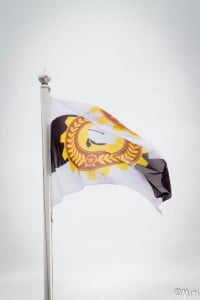
Wappu
Lappeenranta is known in other parts of Finland of three things: ham and boiled egg meat pies, the hockey team of SaiPa and The Longest Wappu in Finland. In student circles mainly of the latter. The kylteri and teekkari wappu of Skinnarila is best known of its length. Depending on the year and other factors Wappu takes on average two to four weeks from April to the second of May – in 2019, we had the longest Wappu ever made which took one month and one day.
During Wappu there are all sorts of events offered for the students. The frame of wappu consists of already established series of spectacles starting with the Wappu call and continuing with e.g. FinnHits party and the hill car race KRuisinKi and finishes with the culminating events of May Day Eve and May Day from teekkari baptism in Lake Saimaa to the May Day picnic. In addition, each year a number of innovative new events take place.
During Wappu student overalls are like a home to students of LUT and they are the dress code in most events of Wappu. In addition, they are the perfect alternative of clothing for the time in between the events. Together with the Wappu call the official overall badge of Wappu is published and it shines in the colors of the guild in charge of Wappu on that year.
The schedule of The Longest Wappu of Finland together with important information will be published in www.suomenpisinwappu.fi.
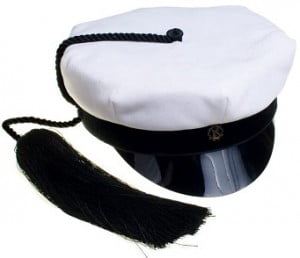
Cap and other symbols
The most important of the external characters of a student are overalls and the teekkari and kylteri caps. LTKY’s office also sels other Lappeenranta student symbols: overall badges, ribbons for anniversary balls, pins and the PunaMusta song book.
Teekkari cap and Kylteri cap
Teekkari cap is similar to the Finnish graduation cap (Finnish students cap) which students can place on their head after graduating from upper secondary school and passing their baccalaureate exams. The Lappeenranta version of the cap has seven corners and a tassel which hangs over the right edge of the cap.
The kylteri cap in Lappeenranta is made from a Finnish students cap by replacing the original cockade with our student union’s symbol. This cockade can be bought from LTKY’s office, and it’s only for business students, as teekkari cap already have the same cockade.
The cap can be worn from 12.00 on the 30th of April till Lakinlaskijaiset (Cap lowering) held during autumn. The right to use the caps is regulated in LTKY’s brand guidelines:
Section 9 § of the Character Guidelines A fresher is a first-year student with a reputation and honor who is a student or creditor studying at LUT-University of Technology. A fresher who has completed the tasks required of them and who has received Teekkari baptism may be awarded the title of Teekkari on the last day of April after dark in Lappeenranta.
Section 14 § of the Trademark Guidelines The right to use the cap can only be granted to a student studying at LUT-University of Technology.
Section 15 § of the Sign Regulations The period of use of the cap begins on the last day of April each year, when the caps are put on simultaneously immediately after the end of the May Day piece. The period of use of the cap ends each year in the autumn, when the caps will be taken off simultaneously at Cap Lowering (Lakinlaskijaiset). At other times, the use of a tech cap in a public place is prohibited. An exception may be granted upon written request by the Secretary General of the Student Union of LUT-University of Technology or the Chairman of the Board or, in their absence, by a person appointed by the Board from among its members.
Ordering Teekkari caps
The co-ordering of the caps is carried out in two ordering rounds, the first in October-November and the second in January-February.
We recommend placing an order in the first round of ordering, as the hat is much cheaper when ordered with it. For non-fresher, the price of the cap is the same regardless of the order round.
Caps will be ordered from LTKY shop and paid upon order. The caps will arrive to the student union a few weeks before vappu.
Overalls
Overalls are protective clothes for students, color of which depends on the field of study of a student. The overalls are meant to be decorated with badges and other additions. Friends and dating couples tend to change different parts of their overalls, in Lappeenranta friends switch sleeves and romantic partners switch pant legs. Overalls may be used freely throughout the year at one’s own discretion, and a number of events have overalls as a dress code.
In LUT-university the colored overalls are determined as follows:
Aether (Lahti international programs) – Dark yellow
Armatuuri (Energy Technology) – White
Cluster (Information Technology) – Red
Dominus (Social Sciences and Communication sciences) – Light Blue
Enklaavi (Business) – Neon yellow
Kaplaaki (Industrial Management) – Navy blue
Lateksii (Computational Engineering) -Fuchsian Red
Ketek (Chemical Technology) – Black
KRK (Mechanical Technology) – Orange
Pelletti (Environmental Technology) – Grey
Sätky (Electrical Engineering) – Green
ESN Lappeenranta has also own overalls for exchange students. Their color is blue.
Our neighbor LAB’s students are also welcome to all our events in Lappeenranta, and thus it’s recommended to learn their overall colors too.
Lappeenranta campus:
LaGeR ry (tourism and hospitality) – Turquoise
LaKOSTE ry (health care and social services) – Dark green
LaKu ry (fine arts) – Black-White
LapIO (building and community technology, mechanical technology) – Black-Red
LapTOp ry (business) – Violet
Lahti campus:
LASOLA ry (healthcare and social services) – Orange
Linkki ry (business) – Blue
LIRO ry (mechanical technology) – Fuchsian Red
Lymo ry (energy and environmental technology) – Fuchsian Red
MIO ry (design and visual communication) – Black
PINO ry (wood technology) – Fuchsian Red
ReLa ry (tourism and hospitality) – Black, pink pockets
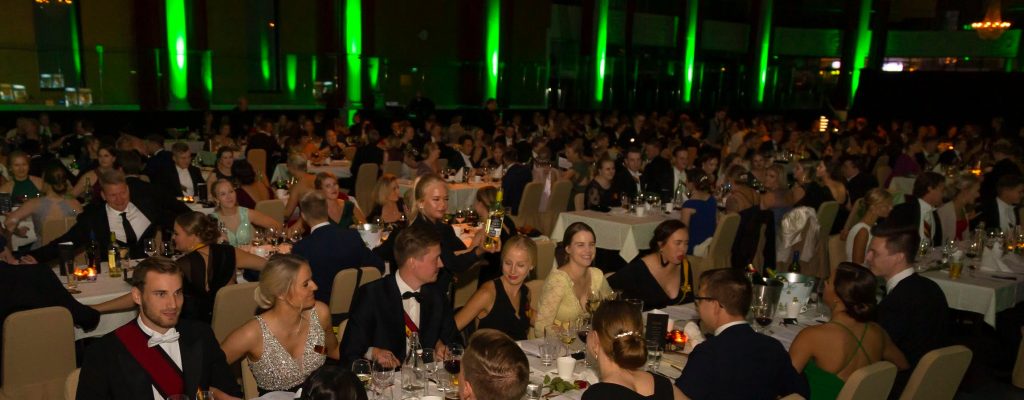
Anniversary
Anniversaries / annual balls are celebrated in honor of the birthdays of a guild, subject organization, association, or any group. Parties follow etiquette and tend to be very similar in structure. Mainly, however, at the annual celebrations, or vujut, people eat, drink, sing and dance nicely.
The celebration usually starts with a cocktail party (fin. kokkarit). Traditionally there have been invited guests presenting their greetings, thanks and some imaginative gift to the party organizers. Cocktail party usually has some small snacks and drinks for participants.
After the cocktail party, the main party itself can begin. The main party will feature a three-course dinner, familiar and unfamiliar songs will be sung, and program numbers will be followed. Depending on the organization celebrated, the program may include a keynote speech, rewarding commendable students or alumnus, a speech by the chair of the organizing body, a speech for a woman, or a free program ranging from a choral song performance to a drag show. The main party is usually concluded with dances accompanied by the band.
The party will, of course, move on to an after party. In the after party, it is possible to get more food and drink and a live band will normally play on site. The duration of the after party has not been determined and fewer quest actually remember, how long the after parties went on.
The next day of the annual ball is brunch or sillis. These differ from each other mainly on the basis of the dresscode, as the brunch dresscode is a hokinait (cocktail but more casual and fun) while the sillis has overalls and a theme. In the brunch and sillis participants eat and drink, and often they also go to sauna ja listen to music, live or from a streaming services. The organizing body may have organized something on the spot, too. From a brunch or sillis, there is usually still a chance to go to a new after party, where the annual celebrations will officially end at the latest.
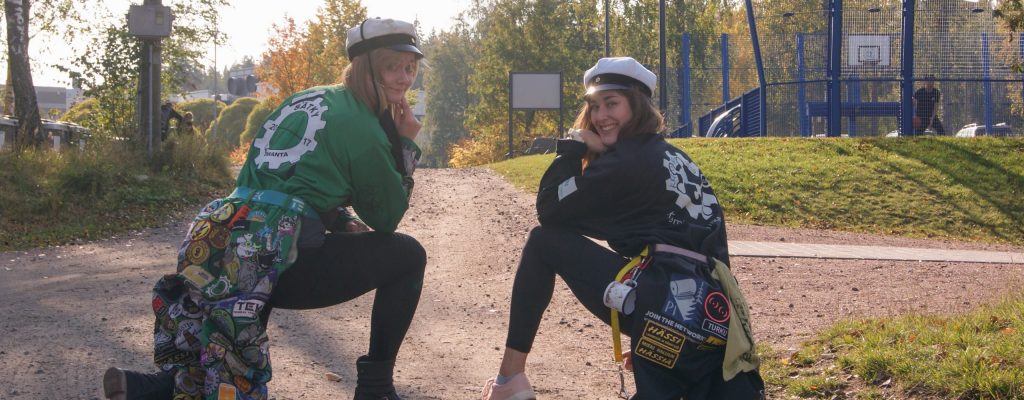
Dress code
Lappeen Ranta student events use very different dress codes, ie dressing instructions depending on the nature of the event. Often an invitation or poster for an event states a dress code, which can be one of the more traditional ones, such as smart casual or something else. This quick guide opens up a bit of what is meant by the most commonly used dress code in Skinnarila.
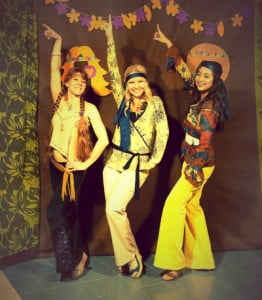 Often at events there is no dress code at all, so you can decide for yourself how to dress (although dressing itself is desirable). The event can also have a theme that is recommended to follow as much as you can, preferably from bottom to top. And it’s also fun to dress up! Normal clothes you can use any other day, so dressing up once in a while won’t hurt anyone.
Often at events there is no dress code at all, so you can decide for yourself how to dress (although dressing itself is desirable). The event can also have a theme that is recommended to follow as much as you can, preferably from bottom to top. And it’s also fun to dress up! Normal clothes you can use any other day, so dressing up once in a while won’t hurt anyone.
Check out flea markets, second-hand stores and also your parents (or older students’) wardrobes for themed clothes!
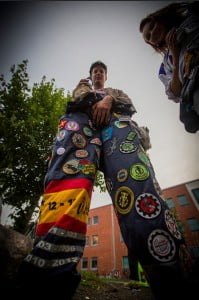 Overalls is probably the easiest and most used dress code. Just put your overalls on and let’s go! If you don’t yet own overalls, or their location is unknown for some reason, it’s always perfectly fine to arrive in normal clothing. But be careful: overalls is not a cloth you can put to any situation, and it should never replace some other dress code. If you don’t know, if overalls are appropriate, it’s recommended to arrive with normal clothes. Themed dress codes are also without overalls, unless mentioned separately (e.g. overalls + after ski).
Overalls is probably the easiest and most used dress code. Just put your overalls on and let’s go! If you don’t yet own overalls, or their location is unknown for some reason, it’s always perfectly fine to arrive in normal clothing. But be careful: overalls is not a cloth you can put to any situation, and it should never replace some other dress code. If you don’t know, if overalls are appropriate, it’s recommended to arrive with normal clothes. Themed dress codes are also without overalls, unless mentioned separately (e.g. overalls + after ski).
After scaring you, it’s good to tell that after all, overalls are the most common dress code and there aren’t so many situations where you go wrong with them. Especially during wappu and freshmen weeks, the general dress code is overalls, except events where dress code is stated otherwise. Outdoor events are also typical places to use overalls, as they’re relaxed, warm and also no need to be afraid sitting on the grass. However, when you go to nutrition shops in the city centre, leave your overalls home unless it’s a designated overalls party.
There are numerous different versions of the dress guides for Smart Casual. However, there are two commonly used in Skinnarila: more festive and more mundane. Smart casual, hokinait and cocktail are basically the same, and they only vary in the formality and situation. Smart casual is for the more free-form connections.
The more mundane smart casual is usually worn for business contacts, i.e. either during a business visit, case evening or other similar. In this case, you’ll need a so-called business casual look, instead of a party dress. This usually means neat jeans, a collared shirt, and possibly a casual suit jacket or trouser pants with a more informal top, or a pencil skirt with a casual top or pants combined with a neat shirt and jacket.
For a more formal smart casual, you can also wear a jacket suit or a neat knee-length dress and jacket with it, or a neat casual suit (which can also be any color other than dark grey or black, and tie is not mandatory).
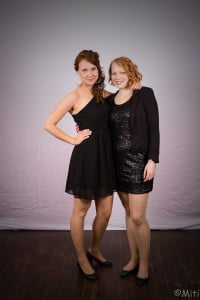 Hokinait is a commonly used, festive but casual dress model in Skinnarila that, despite its name, does not mean orange jackets or hockey outfits. Instead, it is a dress code between smart casual and cocktail. As this is a slightly more informal dress pattern, it allows for more variation, too.
Hokinait is a commonly used, festive but casual dress model in Skinnarila that, despite its name, does not mean orange jackets or hockey outfits. Instead, it is a dress code between smart casual and cocktail. As this is a slightly more informal dress pattern, it allows for more variation, too.
Hokinait is mostly the same as smart casual, meaning neat jeans or a little black dress, which can also be a colored or skirt and a slightly more festive top. They can be combined with a casual jacket or, for example, a neat cardigan. Hokinait allows also different kind of suits, e.g. a violet velvet suit/costume. A suit or tie can also be worn for a more festive occasion.
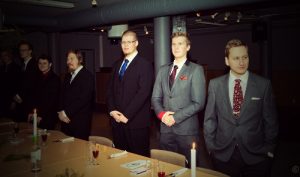 The nature of the event affects the dressing with cocktail dress code. Guideline is that in cocktail event you dress like you would go to your cousin’s wedding. The best option is a suit, or a knee high dress, and if needed, a jacket, bolero or a scarf to cover up shoulders. For more fancy occasion you can choose a colorful dress shirt or have fun with a tie.
The nature of the event affects the dressing with cocktail dress code. Guideline is that in cocktail event you dress like you would go to your cousin’s wedding. The best option is a suit, or a knee high dress, and if needed, a jacket, bolero or a scarf to cover up shoulders. For more fancy occasion you can choose a colorful dress shirt or have fun with a tie.
The tailcoat can be worn at Skinnarila only on the most valuable occasion; at the academic anniversary celebrations (vuosijuhlat, vujut), when the suit can be accompanied by academic decorations and a municipal and/or guild ribbon, the purpose of which is to tell which party the student proudly represents at the celebration. LTKY’s municipal ribbon has the colors of Karelia; the edges are black and there is a red stripe in the middle. You can find more detailed instructions for using the municipal tape in Chapter IV of the Acknowledgement regulation. A common guideline is that you should NOT attach anything to the municipal ribbon that does not belong to it, such as your own municipality or guild’s pin, even if they fit well on the ribbon.
Tailcoat dress code includes (surprisingly) a tailcoat, with its own loopless pants with a satin ribbon on the side, a tail coat, a white tailcoat, a white vest and a white bow, as well as cufflinks and laurel shoes. There is no belt with a tailcoat, so you should wear suspenders if you are afraid your pants will drop. You can use a pocket watch with a tailcoat if you wish.
Instead of a tailcoat, you can wear a long evening dress that covers your ankles and according to the label, is not a trouser suit. The dress can be open, but then you should have a festive bolero, stole, or scarf to cover your shoulders. A festive fabric is often chosen, jewelry can be spectacular and a small evening bag is used.
The tailcoat can also be replaced with a dark suit if desired. The suit must then be black or almost black, the shirt white and the tie low-key. At Skinnarila, at the annual celebrations, it’s also common to see a tie that matches the color of their avec’s dress or suit, but the ties should not be patterned. For example, a dark blue or pearl gray tie is always a sure option.
Student prank
Student prank, aka “Jäynä”, is an essential part of Karelian student culture, and it is up to every student in Lappeenranta to cherish the tradition. Pranking is not difficult, and even with small resources, it can be successful and exhilarating. You should be proud of a successful prank, as it is a Karelian student culture at its best!
The essence of the real student prank is often a mischievous but benevolent device, insight, or performance that is sometimes close to the boundary of what is proper. The purpose of the prank is to produce fun for the doer, the target and the general public.
Student prank has always been the cornerstone of student culture in all student communities, fostering the collective spirit of the students. It has also shaped the public’s perception of the Teekkari culture as in good and not-so-good. The student prank thus acts as a messenger of the Teekkari culture hence it is important that student prank does no harm to anyone.
What is cool and what’s not is defined in the rules of Lappeenranta’s Jäynäkisa, which each Prankster must read before starting pranking.
